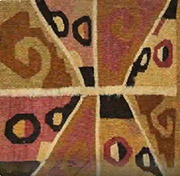Center, Textile Research

IX Jornadas Internacionales de Textiles Precolombinos y Amerindianos / 9th International Conference on PreColumbian and Amerindian Textiles, Museo delle Culture, Milan, 2022
Date of this Version
2024
Document Type
Article
Citation
DOI: 10.32873/unl.dc.zea.1610
Published in IX Jornadas Internacionales de Textiles Precolombinos y Amerindianos / 9th International Conference on Pre- Columbian and Amerindian Textiles, Museo delle Culture, Milan, 2022. (Lincoln, Nebraska: Zea Books, 2024)
Abstract
Los textiles excavados por el proyecto arqueológico Nasca-Palpa en el Departamento de Ica provienen de dos asentamientos y un sitio sagrado cerca de la ciudad moderna de Palpa. En base a los datos arqueológicos se clasifican los textiles en varios rasgos de la cultura Nasca (200 aC – 650 d.C.): Los asentamientos fueron habitados permanentemente durante un largo período y, además, periódicamente, fueron utilizados como cementerios. Los hallazgos textiles son de tumbas de diferentes periodos, formas y sectores de los asentamientos. Paralelamente se trata por primera vez de textiles de capas compactas de áreas habitadas y además de todas las fases de la cultura Nasca. Estos textiles permiten examinar las actividades cotidianas de los Nascas – en zonas residenciales, en zonas de tareas administrativas y en zonas para ceremonias religiosas. Los hallazgos textiles del tercer sitio proceden de una ofrenda cerca de un geoglifo y apuntan a la utilización de textiles en ceremonias religiosas. Para la evaluación, los textiles fueron resumidos y comparados en varias combinaciones de contextos. También refleja que los asentamientos en diferentes períodos tenían diferentes características sociales con referencia al tamaño, las características de los sectores y el estatus social del asentamiento en la sociedad Nasca.
The textiles excavated as part of the archaeological Nasca-Palpa project in the department of Ica come from two settlements and a sacred site near the modern city of Palpa. Based on the archaeological data, the textiles are assigned to different contexts of the Nasca culture (200 BC – AD 650): The settlements were permanently inhabited over a long time and also served temporarily as burial sites. The textiles recovered from burial sites originate from graves of different periods, forms and sectors of the settlements. Furthermore, for the first time we are dealing with textiles from compact layers from inhabited areas - of all cultural phases. These textiles make it possible to study the daily lives of the Nasca - in residential areas, in areas of administrative tasks and in areas for religious ceremonies. The findings of the third site are from an offering near a geoglyph and indicate the use of textiles in religious ceremonies. For the evaluation, the textiles were summarized and compared in various combinations of contexts. It also reflects that the settlements in different periods had different social characteristics in terms of their size, the characteristics of individual settlement areas, and the status of the settlement within the social structure of the Nasca society.
Included in
American Material Culture Commons, Art and Materials Conservation Commons, Fiber, Textile, and Weaving Arts Commons, Indigenous Studies Commons, Latin American History Commons, Museum Studies Commons, Native American Studies Commons, Other History of Art, Architecture, and Archaeology Commons, Other Religion Commons


Comments
Copyright © 2024 Daniela Biermann